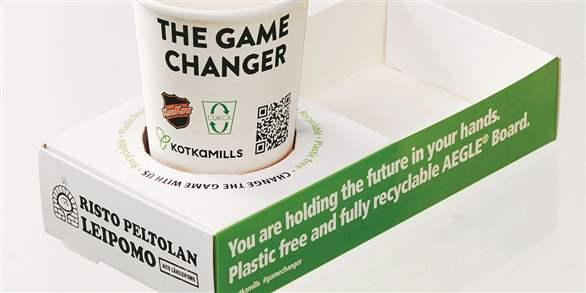How IoP Can Connect the Packaged Food Value Chain
PACKAGING
The Internet of Packaging (IoP) is the application of the Internet of Things to packaging. It is an expansive area that has the potential to address new and old challenges in the packaged food industry. IoP facilitates autonomous data capture, event transfer, network connectivity, and interoperability when it is aligned with the Fourth Industrial Revolution, which links physical, biological, and digital sciences. Consumer, retailer, brand owner, packaging, and ingredient supplier levels have already been enhanced by IoP, and meaningful value can be transferred by linking the entire value chain with IoP.
IoP has the most potential when it is applied across the value chain. The need for more sustainable foods and packaging, less food and packaging waste, improved authentication of products, enhanced food safety, better branding, and improved tracking and tracing of products creates a plethora of IoP opportunities. The engagement of the entire value chain enhances benefits and lowers the cost of implementation. For example, IoP can reduce food waste by assessing shelf life via smell, vision, and taste sensors; address food safety via tracking and tracing; enable more reuse and recycling by conveying location-specific package disposal information; and increase efforts to make the sourcing of food and packaging materials more sustainable.
IoP and Branding
Consumers have experienced smart packaging that connects them with product brands, but IoP has the potential to do more. IoP provides enhanced agility and the opportunity to create meaningful connections between consumers and brands. Operational efficiency is high in many manufacturing environments, and the focus is on high volume production. But manufacturing packaged foods that are sold to consumers six to 24 months later does not always align well with the most recent consumer trends. To address this, IoP gathers consumer information to guide manufacturing needs. IoP can provide real-time consumer feedback on frequency, time of use, and personalized additions to guide more agile manufacturing; it can provide a direct link to consumers who shop at brick-and-mortar stores or purchase goods online. Essentially, IoP serves as an invitation from brand owners to consumers: IoP allows brands to enter into consumer homes and add value when consumers interact with packages. For example, augmented reality and voice technology can offer unique engagement activities through packaging along with repeat sales—driving brands deeper in the home.
Packaging equipped with augmented reality capabilities such as Snapchat-based digital scans on McDonald’s packaging and the images and sounds of polar bears and holiday music on Coke cans are being used to elevate and control the consumer-brand connection. Francesco Rinaldi pasta sauce will soon be available in a sustainable jar that connects to an app through which Mrs. Rinaldi can speak to consumers about the product. This type of IoP integration can be expanded to allow packaging to provide more meaningful consumer experiences with brands. With IoP assistance, food fraud and recalls can be guided by data that pinpoints the source of fraud or other brand-damaging issues in seconds versus weeks.
IoP and Package Waste
IoP packaging could be used to provide consumers with location-specific disposal information, which would facilitate appropriate recycling, reuse, incineration, or composting of packaging waste. IoP technologies can also be configured to potentially give consumers the ability to get rewarded for their environmental efforts. In areas where package collection generates revenue and in communities with higher disposal fees due to poor sorting, this would assign a value to proper package disposal. When more advanced IoP replaces current label capabilities, location specificity can link to local deposit return systems. After being collected, packaging waste must be sorted and correctly handled. IoP systems can track collection and sorting, gathering information on which company’s packaging was received, the speed at which it was sorted, and where it was sent for processing (i.e., recycling, reuse, landfill, composting, or incineration). This can be used to assign disposal costs as well as provide direction for the development of packaging that is appropriately handled in the post-consumer environment. When information can be supplied from packaging disposal, manufacturers and post-consumer handlers gain knowledge to drive the circular economy and increase recycling and reuse efficiencies. For example, Kotkamills, a Finlandbased company, provides QR codes that inform consumers about the proper disposal of its paperboard-based foodservice packaging.
IoP, Food Safety, and Food Waste
IoP also connects with consumers to improve food safety and reduce food waste. For example, blockchain-based IoP works securely and autonomously, enabling tight track-andtrace through the entire value chain, which improves food safety for consumers. “Blockchain traceability enables exponentially fast and accurate identification of a contaminated product and speeds investigations and recoveries. Pilots such as Carrefour’s in France demonstrate that consumers purchase more food that is tracked via blockchain than food not tracked by blockchain,” says Dawn Jutla, co-CEO and president of Peer Ledger. Recent outbreaks of E. coli in romaine lettuce, Salmonella in pork, and the presence of per- and polyfluoroalkyl substance migrants in packaging highlight the need for improved tracking and tracing in food as well as in packaging. Bumble Bee Foods puts QR codes on packaging, which allows consumers to know the source of tuna within the package. IoP technologies that address food safety will be instrumental to the updated food safety approach under the Food Safety Modernization Act.
To address food waste, sensors with detection limits for oxygen, other single molecules, or specific microorganisms employ technology adapted from the medical industry and have been constructed to address chemically complex quality factors such as taste, odor, toxicity, or freshness. In another scenario, after a product’s expiration date passes or after the product has been exposed to temperature and humidity that reduces its quality, sensors can release activated carbon to deactivate the product so that it can be disposed of properly by the consumer.
IoP and Sustainable Practices
Increasingly, consumers want to know the source of packaging (e.g., sustainable forests, fossil fuels, iron or bauxite mines, recycled content, number of times reused), how it was produced (solar, wind, fossil fuels), and its proper disposal. However, without track and trace from packaging converters, this is not possible. Track and trace is needed in packaging because packaging is the culmination of work at many packaging converters. For example, a five-layer flexible film is typically the result of extraction, polymerization, coextrusion, printing, and lamination—each stage performed at different packaging converters. The inability to track and trace package contaminants to the root cause or locations hampers the safety of the food system. IoP technology such as blockchain can enable track and trace, inhibit further damage, and hold the source of the contamination responsible. Starting at the packaging supplier and continuing throughout the value chain, tracking and tracing add value and justify the cost of the technology. IoP can also make an enhanced connection between consumers and brands on product sustainability. For example, Nestlé employs augmented reality linked to a smartphone to create associations between Milka chocolate and animal welfare.
IoP and Retail, Foodservice, and Other Channels
With unharmonized standards and multiple software and hardware systems as well as security obstacles, IoP represents an overwhelming set of new challenges for retailers, foodservice providers, and alternate food provider channels. IoP is sprouting in every aspect of the retail value chain and shopping experience. For example, consumers walking through South Korean subways can scan QR codes from packaging and order the products from their phones. Hema’s digitalized stores in China use freshness sensors and smart tags that change prices based on competition and promotions and tags notify workers when to replenish or rotate the stock. Kroger uses ZigBee retail services to bring smartphone applications, point-of-sale devices, and streaming video together in one platform to reduce theft and track inventory. SmartLabel QR codes on products allow consumers to interact with the SmartLabel website, which then provides information to supply chain stakeholders. Autonomous systems minimize warehouse time while delivering the product to a physical store or home. IoP can also help reduce food waste at retail and foodservice establishments. “IoP blockchain traceability reduces food waste … because there are accurate records of where contaminated materials have traveled. This avoids the need to discard millions of pounds of food as a precaution due to uncertainty of whether products are contaminated,” Jutla says. IoP can be applied to increase viable food donations from retailers to alternate channels such as food depositories and pantries and facilitate the rapid balance of food as well as nutrients available for their clients. In reusable foodservice packaging, IoP uses sensors that change color when the exact time and temperature required for sterilization are achieved to enhance the food safety of reusable foodservice packaging. While all of this represents exciting developments, many standards, configurations, plans, guidelines, and so on must occur to make IoP successful.






